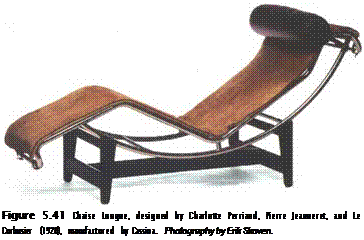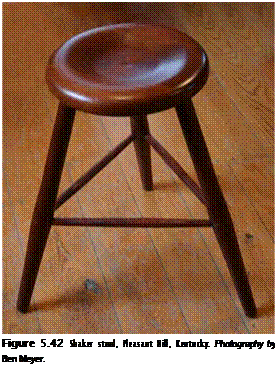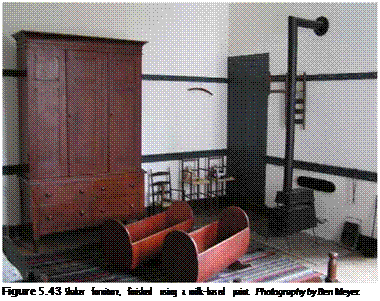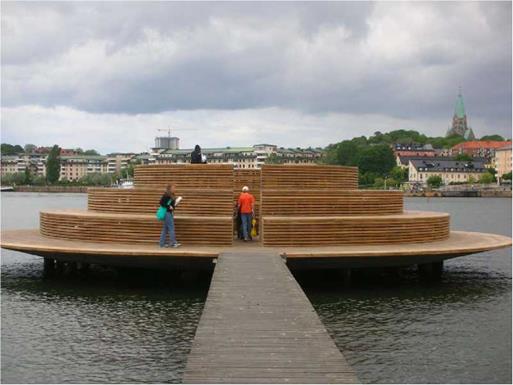 People from different cultural backgrounds view the built environment in different ways. Correlations between furniture, culture, and use develop into complex associations between built form and culture. Culture is a frame of reference through which furniture is given social meaning, but culture is not the only referent. The 1960s was a time of social change for many people. It was time to question authority, and in design, it was a time when designers began to focus upon humanist perspectives including program briefs and post-occupancy evaluations (POEs). POEs are research studies that focus upon a building after it has been occupied and used for a period of time. Scholars, architects, and designers sought stronger relationships between design theory and humanist theory. The late 1960s marked a renewed interest in programming, which focused attention upon the processes and methods used to better design complex buildings. It was also the time when vernacular design began to reemerge as something deeper than a minor interest in cultural geography. John A. Kouwenhoven coined the term vernacular to refer to designs carried out in everyday or routine ways without much conscious or formal planning.28
People from different cultural backgrounds view the built environment in different ways. Correlations between furniture, culture, and use develop into complex associations between built form and culture. Culture is a frame of reference through which furniture is given social meaning, but culture is not the only referent. The 1960s was a time of social change for many people. It was time to question authority, and in design, it was a time when designers began to focus upon humanist perspectives including program briefs and post-occupancy evaluations (POEs). POEs are research studies that focus upon a building after it has been occupied and used for a period of time. Scholars, architects, and designers sought stronger relationships between design theory and humanist theory. The late 1960s marked a renewed interest in programming, which focused attention upon the processes and methods used to better design complex buildings. It was also the time when vernacular design began to reemerge as something deeper than a minor interest in cultural geography. John A. Kouwenhoven coined the term vernacular to refer to designs carried out in everyday or routine ways without much conscious or formal planning.28
Sociologists, cultural anthropologists, engineers, and psychologists have developed a body of knowledge that has advanced the importance of cultural and social theories in design and architecture. The groundbreaking work of Irwin Altman, Leanne Rivlin, Amos Rapaport, and Edward T. Hall led to second – and third-generation scholars such as Michael Brill, Clare Cooper Marcus, David Saile, David Seaman, and Setha Low, who have contributed to the study of environment and social behavior. The fields of sociology, cultural anthropology, and cultural geography, in conjunction with the study of transgenerational design and advanced studies of ergonomic relationships, have all contributed to a body of knowledge useful to furniture designers. Contemporary furniture designs express societal and cultural meaning, despite how subtle the references may appear to be.
Our evolving understanding of societies and cultures relative to built forms has influenced the collective view of theory, making humanism a primary consideration in design research. Theory began to shift its perspective from aspects of form and function (modernism) to more humanistic, societal, and cultural orientations during the late 1960s. Furniture designers began to break traditional and conventional rules of design, which in turn opened the door for new ideas and paradigms about furniture and design. The period from the late 1960s to the mid-1970s was one of formal and social experimentation in furniture design. Studies about the experience of furniture began to emerge in humanistic and user-centered research. Placing people first generated an interest in indigenous societies, vernacular design, and cultural geographies, and this in turn fueled an emergence of knowledge that evolved into built-form and cultural research and formation of the Environmental Design Research Association (EDRA).
Furniture addresses the needs of larger societal and behavior patterns that belong to specific institutions, regions, or global communities. Regarding societal patterns of behavior, furniture can be fully integrated within the daily life of people, as seen in the outdoor chairs
 |
 |
and tables in many European cafes. For millennia, places of worship have embodied evolving and collective patterns of liturgical use. A pulpit rising well above freestanding chairs or pews hardly seems out of place, as do vernacular Turkish furnishings, Shaker furnishings hung on pegs on a wall when not in use, or office workstations arranged in a grid. In every case, when a clear sense of cultural identity aligns itself with any given standard in regard to established patterns of behavior, links between furniture and specific societal groups appear seamless, revealing correlations between the behaviors and values of these groups and design.
Consider Shaker furniture and reflect upon the image that comes to mind (Figure 5.42). Most likely, the image is of a naturally finished, handcrafted wooden stool, table, or box. But this can be argued as "out of step" with what is Shaker. Shaker culture can be diagrammed as one that grew in the early 1800s, reached its zenith in the mid-1800s, and then began its descent by the end of the nineteenth century. At the beginning and ending points of this culture, Shaker furniture was well crafted, naturally finished, and expressively detailed. No one piece was exactly like another, and the workmanship and wood grain were valued by both the maker and the user. At the height of the Shaker culture, furniture and millwork were painted with a milk-based paint (Figure 5.43), which gave a uniform appearance to the furniture and casework. All woodwork was made to appear similar. Different woods could be used and the paint hid the faults, details, wood grain, and craft distinctions, generating a formal and social sameness of the furniture. This way of thinking about furniture reflects upon the correlations between culture and built form. Althought the Shaker way of life has long since disappeared, its furniture remains popular today, but it is the natural, uniquely crafted pieces that are popular rather than the painted works, calling into question whether Shaker furniture is deeply appreciated as a cultural phenomenon or as a handcrafted work of beauty.
People around the world interact with the built environment in different ways. Distinctions in the way people interact with one another and with built forms can be seen as cultural folds, which in turn help define the seams between local, regional, and global
communities. The terms local and regional have geographic and vernacular boundaries. People who live in a particular place and time tend to generate a collective identity through a shared view of how things are done.
Despite the economic influence that global corporations have on design worldwide, the intent and extent of the origin of design contributes to the nature of its regional versus global status. Global design is similar to universal design by definition, immune from local or regional boundaries. A left – or right-handed computer mouse and the Segway transportation device are examples of products designed for a global community, without the influence of regional nuances or local ways of doing something.
Consider the communal nature of a sauna experience and the influence of the built-in wood seating on the enjoyment of a sauna with others. Finnish, Norwegian, Swedish, and Danish people understand the rituals, conditions, and communal experiences that determine this specifically Scandinavian practice, which indeed is culturally distinct from how a sauna might be understood and experienced elsewhere in the world. Consider the outdoor gathering place located in Hammarby Sjostad, Sweden (Figures 5.44 and 5.45), and try to formulate connections between its design and intended use and the deep cultural heritage its designers drew upon to express a sense of place and regional identity.
 |
 |
Similar transformations occur whenever a regional norm is well established. However, disconnections between form and meaning begin to emerge when spaces and objects rooted in one culture are placed in a completely new cultural or geographic context. This has occurred many times in history: oriental rugs or kilims brought to Europe; the furnishings of Britain exported to India, the Chinese sea captain’s chair copied for a dining suite in South Africa. This even occurs between generations when antiques and furnishings are transferred to grandchildren who live in societies that are significantly different from those of their grandparents or great-grandparents. Furniture, because of its mobile and temporal nature, often introduces a mix of cultural heritages and patterns of behavior to its setting and to its users.



